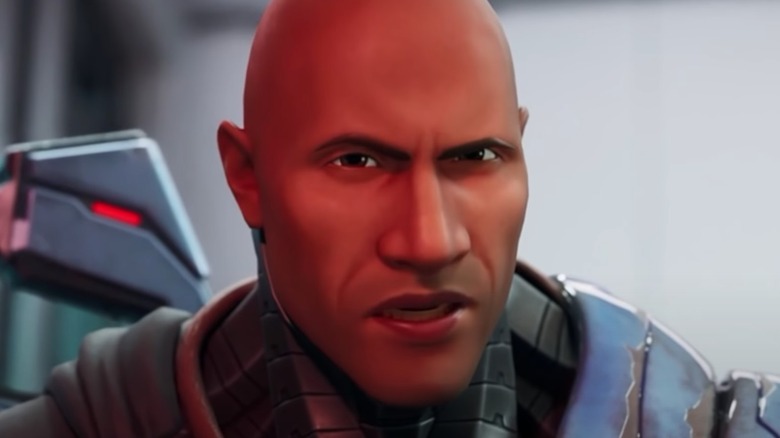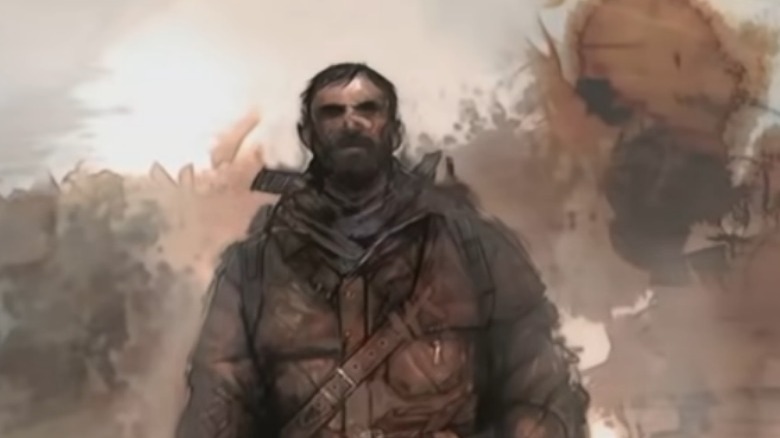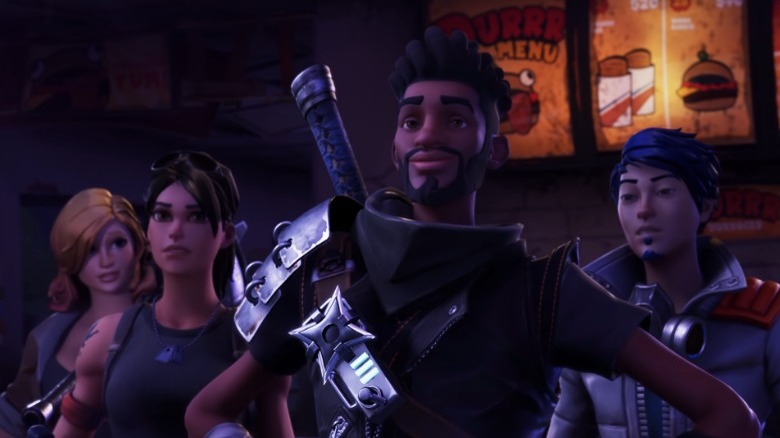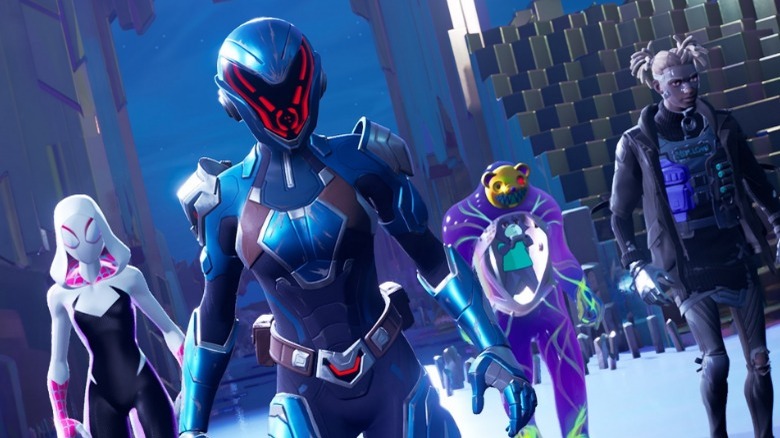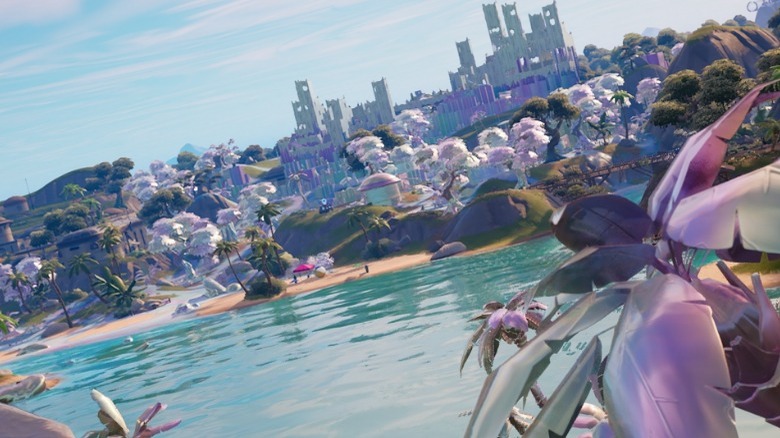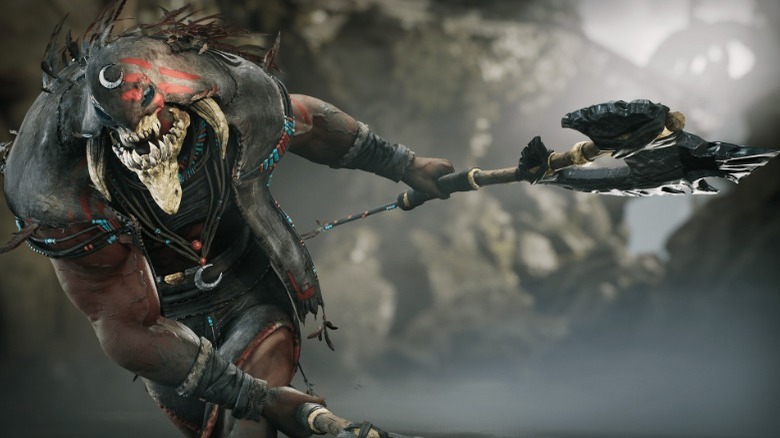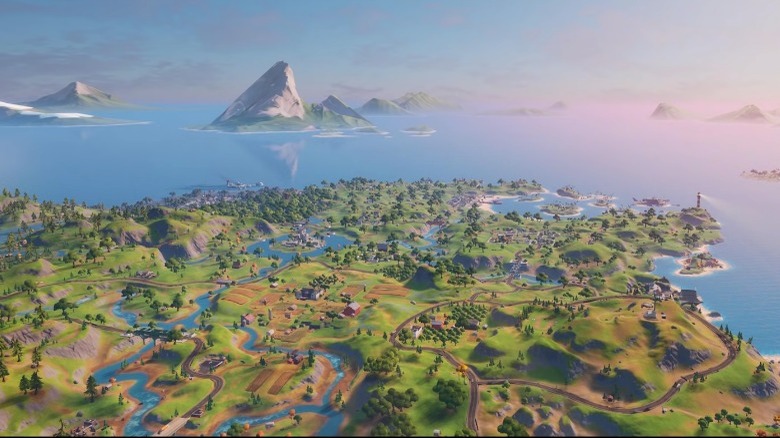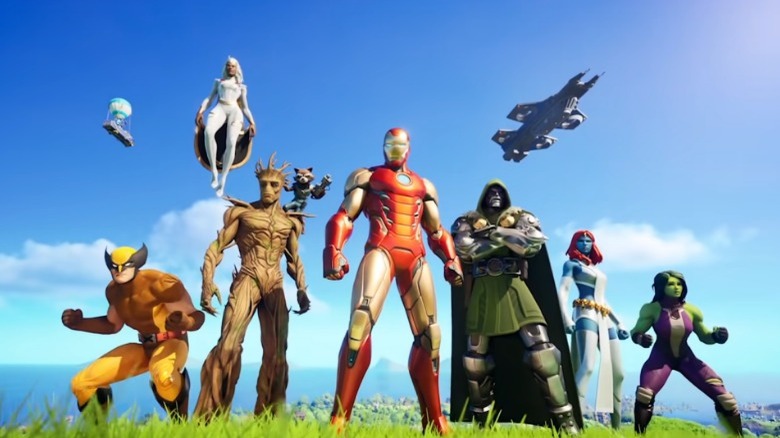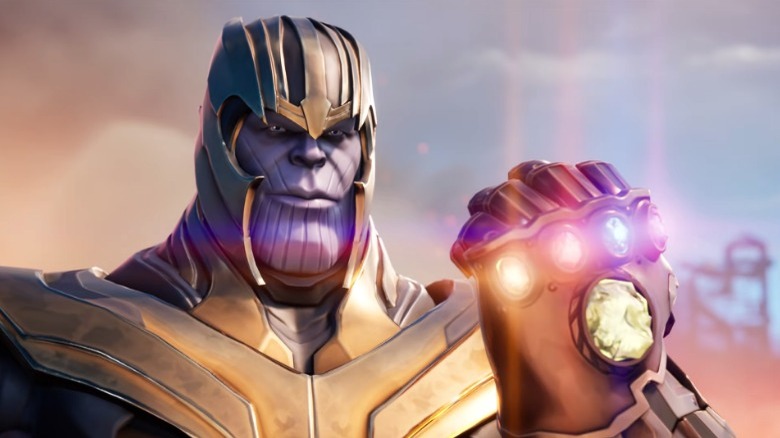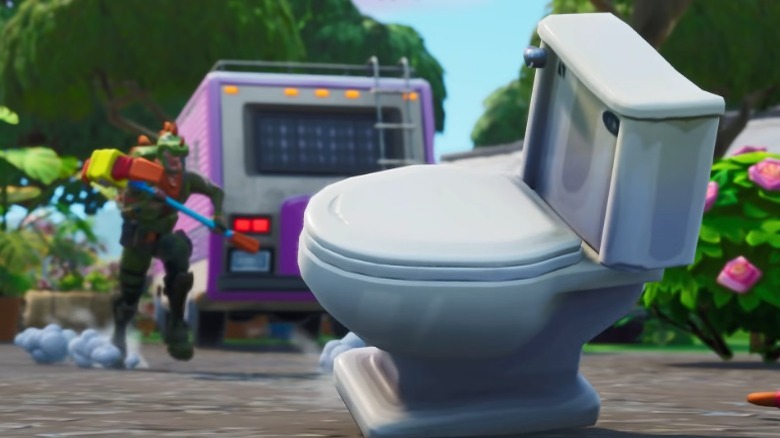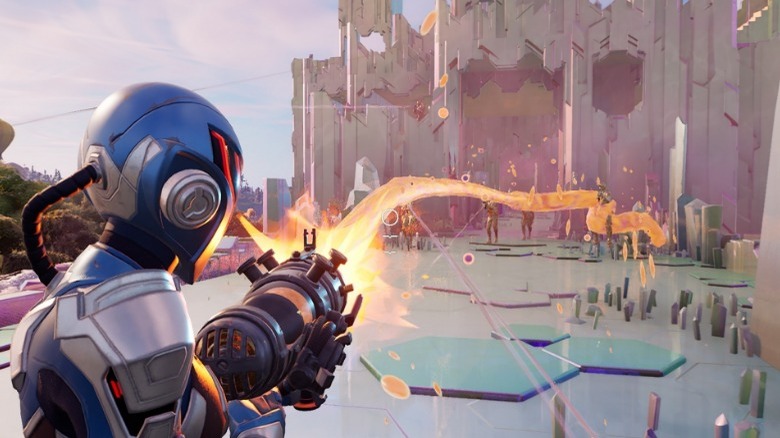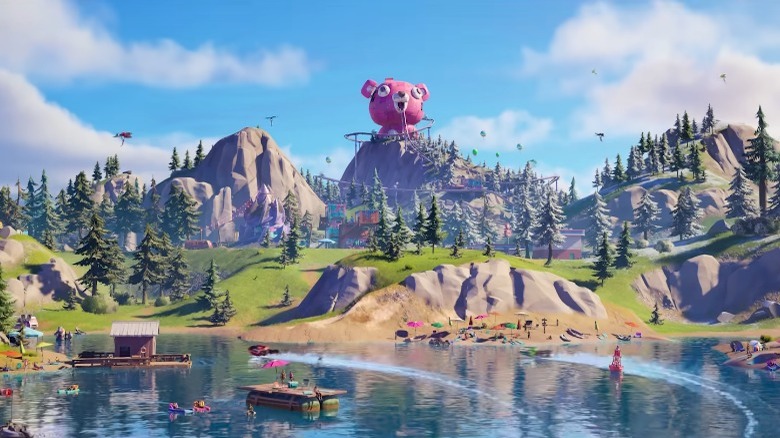Fortnite's Evolution Happened Just How It Needed To
"Fortnite" is arguably one of the most recognizable video games in today's market. The title sets itself apart from other battle royale games with stylized graphics and a building system that lets players tear down structures and replace them with their own haphazard towers. However, like most video game developers out there, Epic Games didn't nail the aesthetic of "Fortnite" in one go.
Early versions of "Fortnite" barely resemble the finished product, which is itself a misnomer. Since "Fortnite" is a live service, Epic Games keeps tweaking and occasionally reinventing the game through patches. Sometimes these updates completely alter the meta by changing the weapons players can find, and other times patches invite famous pop culture icons to serve as cosmetic items or even hold special concerts.
You might be surprised to learn just how much "Fortnite" has changed in the five years it's been around — and the additional six years it was in pre-launch development.
Shifting art styles
You can't judge a book by its cover, but you can attract an audience with one. To stand out in a crowd, video games need to sport striking visual styles. Sometimes, a game trailer shows off an aesthetic that instantly hooks viewers. Other times, a company decides to go back to the drawing board, figuratively and literally, before release. "Fortnite" is the latter.
When Epic Games initially announced "Fortnite," the game sported a very different look. Instead of the pleasing, cartoonish graphics fans are familiar with, "Fortnite" utilized darker, more realistic aesthetics. Sure, facial features were still exaggerated, but the characters and monsters wouldn't have looked out of place in a survival horror game — because that was the initial plan.
As dark as the teaser trailer was, it was actually toned down from Epic Games' original concept art. During GDC 2018, Vice President of Art at Epic Games, Pete Ellis, held a lecture on the development process of the art style in "Fortnite," and he revealed some surprising early ideas. The game started with a gritty, realistic aesthetic and a color palette of various grays and browns. No exaggerated proportions or colorful costumes, just as much realism as the developers could cram into their drawings. Every aspect of this "Fortnite" prototype, including monster designs, was meant to deliver an oppressive, dangerous atmosphere.
As interesting as these early concepts appear, the more realistic art style probably would have clashed with the current fun attitude of "Fortnite."
How Unreal
Epic Games created the Unreal Engine for, fittingly enough, the seminal FPS "Unreal." This graphics engine and its updated versions have powered countless subsequent games, such as Epic's original "Gears of War" trilogy (per IGN). One could argue each Epic Games title showcases the power of the Unreal Engine, but "Fortnite" also displays the engine's evolution.
Since Epic Games started developing "Fortnite" after "Gears of War 3" (via Game Informer), the company prototyped the game using Unreal Engine 3. According to producer Roger Collum, the original "Fortnite" was thrown together with pre-existing Unreal assets. The result was an aesthetic mess, but that's to be expected when you are on a short, game jam-type schedule. As the developers decided they wanted to flesh out "Fortnite" and add more to it, they realized their old engine wasn't up to the task.
In order to turn "Fortnite" into a full-blown experience, complete with progression and mechanics that would keep players coming back for more, Epic Games recruited MMO systems designers. And to support all the new features, Epic Games finally switched over to Unreal Engine 4. According to Wired, "Fortnite" was Epic Game's first project using the new engine. History would repeat itself with "Fortnite Chapter 3," as Epic revealed via Twitter that going forward, the game would switch over to the engine's latest iteration, Unreal Engine 5.
Depending on how long "Fortnite" lasts, players might eventually see it run on Unreal Engine 6.
The name used to mean something
Nine times out of ten, a video game's title ties into a crucial theme or element. Once upon a time, "Fortnite" did the same, but not anymore. Not that it's a problem, mind you.
When Epic Games began work on "Fortnite," the company wanted to step outside its FPS comfort zone and try something different (via Game Informer). The company held a game jam, and although "Fortnite" wasn't actually prototyped during that session, the kernel of an idea was formed — not that most gamers would recognize it in that form.
The initial design idea for "Fortnite" envisioned a co-op hybrid tower defense shooter and survival horror title. The building mechanics that set "Fortnite" apart were there from the start, but Epic team members wanted to implement a more "realistic" system, or at least one inspired by "Minecraft" and "Terraria." And the survival portion of "Fortnite" wasn't just the classic horror game trope of "don't get bitten by zombies" — early concepts of "Fortnite" included farming systems. Many of these ideas were eventually toned down or outright removed for the release of "Fortnite: Save the World."
What most gamers recognize as "Fortnite" (i.e., the battle royale segment) was built in a matter of months and was inspired by "PlayerUnknown's Battlegrounds." Without the latter game, "Fortnite" would probably still be a co-op tower defense title.
How Fortnite was monetized
Whenever a studio releases a game, they have to ask how their product will turn a profit. Do they want audiences to pay a one-time, up-front cost, or would they rather let players in for free and then offer services and cosmetics at a premium? For "Fortnite," the answer was... all of the above.
During GDC 2018, Epic Games' Ed Zobrist talked about the trials and tribulations behind the development of "Fortnite." As previously stated, the mode most audiences associate with the title, the battle royale, was developed in two months, and it wasn't going to be free-to-play. Sort of. Initially, Epic Games wanted to release "Battle Royale" as an add-on that would come free with every purchase of the main co-op mode, "Save the World." But, several weeks before release, the company decided to turn "Battle Royale" into a standalone product with its own price tag of $0. Given the competitive multiplayer's success, that was clearly the right call.
Epic's smart last-minute decision with "Fortnite: Battle Royale" would be the first of many. For instance, the company originally wanted to sell "Save the World" during early access and then convert it into a free-to-play title after launch. Epic backpedaled on that decision once the release date rolled around. Furthermore, Epic experimented with monetization in "Battle Royale." Initially, the game launched with a Season Shop that sold items as players leveled up, but that system was eventually retired in Season 2 and replaced with the more recognizable Battle Pass.
Port until you drop
These days, multiplayer game developers try to cast as wide a net as possible, and what better way to do so than by publishing on multiple platforms? That wasn't always the case with "Fortnite."
Even though Epic Games is probably best known for the original "Gears of War" trilogy, the company got its start developing PC games. While the studio had never produced a title quite like "Fortnite," in a sense the game was also a return to Epic's roots. During an interview with GameSpot, the original designer of "Fortnite," Cliff Bleszinski, revealed that the game was planned to launch as a PC exclusive, if only to make it easier on the studio. Bleszinski didn't want to go through the lengthy approval process for consoles, at least at first. He didn't rule out console ports arriving later down the line, though, which is exactly what happened.
As "Fortnite" grew in popularity, the game released on every platform on the market, including Xbox, PlayStation, Nintendo Switch, and most mobile devices. In 2018, Epic opened the floodgates even further by implementing cross-play so gamers could team up and compete against players on rival platforms. However, in 2020, Apple removed "Fortnite" support from iOS due to an ongoing legal battle.
While players still can't officially download or play "Fortnite" on Apple devices, the GeForce Now app, which is available on iOS, allows them a workaround to stream the game. This loophole will probably remain Apple owners' only option for the foreseeable future.
Success comes at a cost
"Fortnite" started small. Its developers never expected the game to experience such explosive popularity, so when "Fortnite" actually hit, Epic Games was caught unaware. The then-current "Fortnite" team wasn't big enough to keep the content train running at a pace that would maintain audience interest, so Epic execs did the only thing they could think of: cannibalize other projects and funnel their teams into the "Fortnite" machine.
While "Fortnite" was in the midst of an alpha test, Epic announced another game, "Paragon." This title was designed as a MOBA/third-person shooter with an emphasis on verticality, which aimed to give players new avenues of attack unseen in the MOBA genre. While that sounds promising, in late 2017/early 2018, community manager Edgar Diaz admitted on Reddit that "Fortnite" was a higher priority for Epic Games. More importantly, many "Paragon" developers had been reassigned to support that title. "Paragon" was already having retention issues before the shift, but Epic's decision to double down on "Fortnite" at the cost of "Paragon" essentially killed the MOBA.
"Paragon" wasn't the only price Epic paid for "Fortnite," as the company lost one of the creators behind it. While Cliff Bleszinski was on board with "Fortnite" during its planning, he left Epic Games soon after, citing a loss of creative control. He then created Boss Key Productions, developed two battle royale games in the vein of "Fortnite," and then quit the games industry altogether.
Topical topography
The biggest and most important character in any battle royale is arguably the map. Each match, players get to know its points of interest a little more. Over the course of a season, gamers memorize where the best looting and sniping spots are, and their knowledge is tested as arenas gradually shrink during matches. But like any good character, these maps need to undergo development every now and then.
When "Fortnite" launched, the map could almost be considered a work in progress. The geometry was complete, but the map consisted of unbroken greenery with little variation. Loot Lake sat in the middle, while iconic locations such as Dusty Depo and Tomato Town didn't have names. Heck, Tomato Town wasn't even a town, because it lacked buildings until Patch 1.71. As time progressed, Epic Games made even more additions to its map, such as Tilted Towers in Update 2.20. That patch also introduced biomes, even if they were essentially different shades of green until Patch 5.0.
The longer Epic Games spent on "Fortnite," the more radically the map changed. Brand new points of interest cropped up and were subsequently demolished, and every now and then Epic turned the map on its head, figuratively and literally. Chapter 2 (i.e., Patch 11.0) introduced an entirely new island, which was subsequently flooded in Patch 13.0. Then Chapter 3 flipped the island over to reveal a third new map.
Given this history, fans should probably expect Epic Games to release yet another map for Chapter 4.
Fortnite crosses over with everything
The hottest items available in "Fortnite" are guest character skins. Why dress up as a pirate or undead banana when you can play as Indiana Jones or Darth Vader? Modern "Fortnite" gamers are spoiled for crossover choice, but back in the day, these IP meldings were as rare as they were celebrated.
Originally, "Fortnite" was a self-contained IP. Player skins were colorful and eccentric, but they weren't connected to any other properties. That changed in 2018, when Epic Games introduced its first guest character skin. Well, more like a guest character weapon. To celebrate "Avengers: Infinity War," Epic implemented the Infinity Gauntlet Limited Time Mashup, which let one lucky player find the Infinity Gauntlet and turn into Thanos — until they were eliminated and another player claimed the item.
As "Fortnite" continued to evolve, mashups became regular occurrences. New seasons introduced permanent crossover skins, including John Wick, a "Borderlands" Psycho, and characters from "Stranger Things" and "Batman." Come Chapter 2 Season 4 in 2020, the pop culture multiverse and its myriad of IP turned into the "Fortnite" narrative's driving force. Not only did Epic Games crank up the cameos, the company also started collaborating with Marvel and DC to create in-canon crossover comics. While "Fortnite" crossovers are in full force these days, they were at their peak in 2018, when "Fortnite" llamas and the Durr Burger head popped up in the real world as part of an augmented reality game.
Not-so-limited-time events
Like many internet phenomena, "Fortnite" events started small and slowly built their presence. To test the waters, Epic's first "Fortnite" events only slightly shook up the status quo. The company started with "Survive the Storm," a special mission type for "Save the World" that introduced limited-time loot llamas and a new enemy, the Shielder. "Battle Royale" later dipped its toes just as tentatively with a "50v50" battle mode that split players into two giant teams.
As "Fortnite" evolved, so too did its in-game events. While Epic continued to release special themed scenarios focused on competition, the company also started expanding the story of "Fortnite." Chapter 1 Season 3 marked the beginning of this trend with "The Meteor," followed by "Blast Off" and "The Cube." Each event rang in the next season and theme, and also furthered the mystery of the "Fortnite" island. Later events, such as Chapter 2 Season 2's "The Device," sported higher production values and even voice acting. But those events paled in comparison to the live concerts, which started small with a simple Marshmallo moshpit and have inflated in scope, such as when a giant holographic Travis Scott danced for audiences. An event involving Marvel's Galactus proved to be so huge that Twitch's servers became overwhelmed.
"Fortnite" live events are such a big deal, blockbuster movie studios are using them to tease exclusive film clips that don't make it to theaters.
Building a community, one feature at a time
Even though Epic Games developed "Fortnite: Battle Royale" on a compressed schedule, the game launched in a mostly solid state. However, there's always room for improvement.
As "Fortnite" got bigger and technology got better, Epic Games rolled out quality of life improvements that added new systems and mechanics. For instance, in 2018, Epic added a replay system that let players save matches, clip their favorite moments, and post them on the internet. The company also eventually patched in sliding and swimming to give players new ways to travel, as well as a Turbo Build mode that lets players build insane fortresses by holding down a button. Any feature that prevents potential gaming injuries, like carpal tunnel syndrome, is a plus in our book.
Not all of the post-release features were actually "features," though. Some, such as Prop Hunt and Party Royale, were new ways to play. Epic Games even temporarily took away the ability to build with the Zero Build event, which seems antithetical to the point of "Fortnite" itself — but players loved it so much that the company brought Zero Build back as a permanent mode. However, arguably the best "new feature" was the chance to make "Fortnite" history with the Boogiedown Contest. Who wouldn't want their dance skills to be turned into the game's next emote?
A revolving door of weapons, skins, and balances
The longer a live service game sticks around, the more it needs to keep players invested. Adding new weapons is an excellent method of maintaining interest, since new firearms give players new ways to beat the competition. But then, balance issues start cropping up.
When "Fortnite" launched, the game featured a solid roster of firearms, including assault rifles, pistols, and shotguns. Throughout the seasons, Epic Games added more weapon types such as grenade launchers and compound bows, as well as more eccentric items like the grapple gloves. To prevent "Fortnite" from becoming bloated, Epic Games also removes items — or vaults them — every now and then. Sometimes a weapon is vaulted because it is overpowered, other times it is only meant to stick around for a limited time. But, once an item is vaulted, it rarely resurfaces — with some exceptions.
While Epic Games has added and removed countless items, the company has also spent plenty of development hours fixing what was already there. Most of these changes were for the sake of balance, such as tweaking weapon accuracy and damage falloff (i.e., the distance at which weapons deal less damage). However, some alterations have been more cosmetic. For instance, what players now know as the Pistol was originally called the Semi-Auto Handgun, and the Tactical Shotgun was introduced as the Semi-Auto Shotgun. As for the Burst Assault Rifle, it was originally called the Semi-Auto Rifle, only to be renamed for the sake of accuracy — despite its name, the weapon didn't feature semi-auto fire.
Themes are the reason for the season
Virtually every live service game out there with a battle pass spices things up with a new theme each season. But depending on the artstyle — and varying levels of subtlety — these themes can flow together. Nobody has to worry about that with "Fortnite."
While Epic Games was still getting its battle royale legs, "Fortnite" started without a season theme. Weapons and skins were generic and plain, albeit colorful. Epic didn't start injecting wacky themes into "Fortnite" seasons until Chapter 1 Season 2, which coincided with the game's first Battle Pass. Coincidence?
Epic Games started with simple, easy themes such as "medieval," "space," and "winter." These included relatively simpler rewards such as the Axecalibur pickaxe and the Moonwalker skin. As Epic continued developing "Fortnite" and became more confident in its ideas (and the game), the studio tried more experimental (and sometimes vague) seasonal themes. These included various takes on corruption, time travel, and even nanomachines. Chapter 2 Season 4 was a full-on Marvel love letter with events, skins, and weapons based on popular Marvel characters.
These days, Epic includes at least one or two cameos per season — even giving The Rock his own character in The Foundation — but before 2020, it was basically unheard of for the company to build an entire season around references. Truth be told, the Marvel season has yet to be topped.

